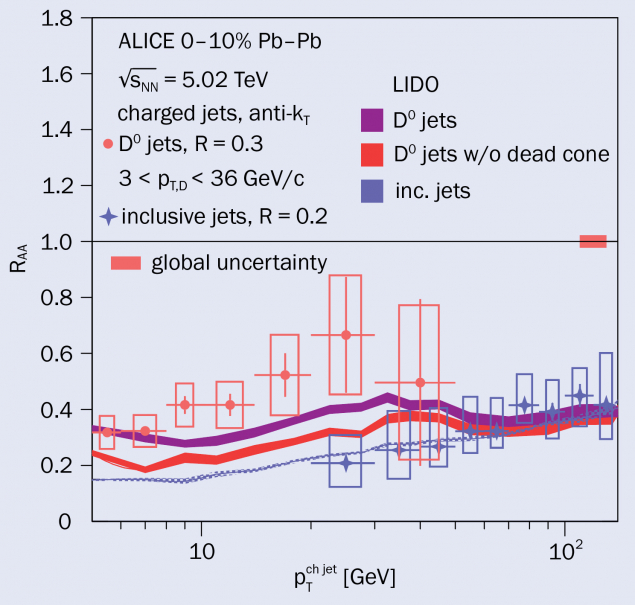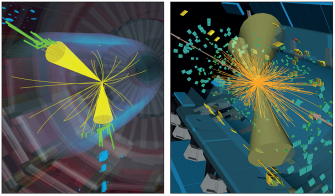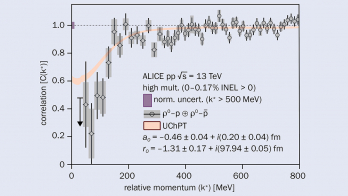A report from the ALICE experiment.

Collisions between lead ions at the LHC generate the hottest and densest system ever created in the laboratory. Under these extreme conditions, quarks and gluons are no longer confined inside hadrons but instead form a quark–gluon plasma (QGP). Being heavier than the more abundantly produced light quarks, charm quarks play a special role in probing the plasma since they are created in the collision before the plasma is formed and interact with the plasma as they traverse the collision zone. Charm jets, which are clusters of particles originating from charm quarks, have been investigated for the first time by the ALICE collaboration in Pb–Pb collisions at the LHC using the D0 mesons (that carry a charm quark) as tags.
The primary interest lies in measuring the extent of energy loss experienced by different types of particles as they traverse the plasma, referred to as “in-medium energy loss”. This energy loss specifically depends on the particle type and particle mass, varying between quarks and gluons. Due to their larger mass, charm quarks at low transverse momentum do not reach the speed of light and lose substantially less energy than light quarks through both collisional and radiative processes, as gluon radiation by massive quarks is suppressed: the so-called “dead-cone effect”. Additionally, gluons, which carry a larger colour charge than quarks, experience greater energy loss in the QGP as quantified by the Casimir factors CA = 3 for gluons and CF = 4/3 for quarks. This makes the charm quark an ideal probe for studying the QGP properties. ALICE is well suited to study the in-medium energy loss of charm quarks, which is dependent on the mass of the charm quark and its colour charge.
The production yield of charm jets tagged with fully reconstructed D0 mesons (D0 → K–π+) in central Pb–Pb collisions at a centre-of-mass energy of 5.02 TeV per nucleon pair during LHC Run 2 was measured by ALICE. The results are reported in terms of nuclear modification factor (RAA), which is the ratio of the particle production rate in Pb–Pb collisions to that in proton–proton collisions, scaled by the number of binary nucleon–nucleon collisions. A measured nuclear modification factor of unity would indicate the absence of final-state effects.
The results, shown in figure 1, show a clear suppression (RAA < 1) for both charm jets and inclusive jets (that mainly originate from light quarks and gluons) due to energy loss. Importantly, the charm jets exhibit less suppression than the inclusive jets within the transverse momentum range of 20 to 50 GeV, which is consistent with mass and colour-charge dependence.
The measured results are compared with theoretical model calculations that include mass effects in the in-medium energy loss. Among the different models, LIDO incorporates both the dead-cone effect and the colour-charge effects, which are essential for describing the energy-loss mechanisms. Consequently, it shows reasonable agreement with experimental data, reproducing the observed hierarchy between charm jets and inclusive jets.
The present finding provides a hint of the flavour-dependent energy loss in the QGP, suggesting that charm jets lose less energy than inclusive jets. This highlights the quark-mass and colour-charge dependence of the in-medium energy-loss mechanisms.
Further reading
ALICE Collab. 2024 arXiv:2409.11939.







